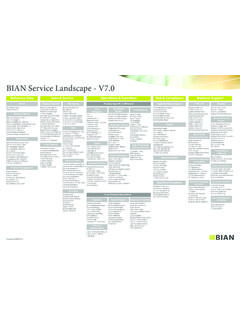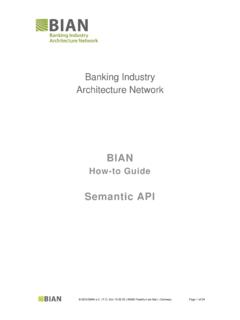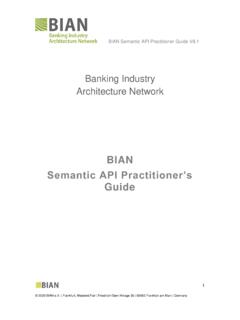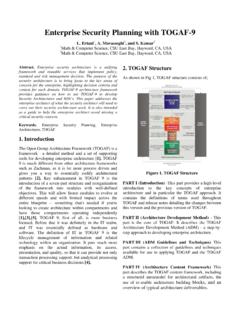Transcription of BIAN
1 Banking Industry Architecture Network BIAN. How-to Guide Introduction to BIAN. Introduction to BIAN How-to Guide Organization Authors Role Name Company BIAN Architect Guy Rackham BIAN. Status Status Date Actor Comment / Reference DRAFT October 2018 Updates Approved Architectural Committee Version No Comment / Reference Date First edited version October 2018. Page 2 of 24 2018 BIAN | Box 16 02 55 | 60065 Frankfurt am Main | Germany Introduction to BIAN How-to Guide Copyright Copyright 2018 by BIAN Association. All rights reserved. THIS DOCUMENT IS PROVIDED "AS IS," AND THE ASSOCIATION AND ITS MEMBERS, MAKE. NO REPRESENTATIONS OR WARRANTIES, EXPRESS OR IMPLIED, INCLUDING BUT NOT LIMITED. TO, WARRANTIES OF MERCHANTABILITY, FITNESS FOR A PARTICULAR PURPOSE, NONINFRINGEMENT, OR TITLE; THAT THE CONTENTS OF THIS DOCUMENT ARE SUITABLE FOR.
2 ANY PURPOSE; OR THAT THE IMPLEMENTATION OF SUCH CONTENTS WILL NOT INFRINGE ANY. PATENTS, COPYRIGHTS, TRADEMARKS OR OTHER RIGHTS. NEITHER THE ASSOCIATION NOR ITS MEMBERS WILL BE LIABLE FOR ANY DIRECT, INDIRECT, SPECIAL, INCIDENTAL OR CONSEQUENTIAL DAMAGES ARISING OUT OF OR. RELATING TO ANY USE OR DISTRIBUTION OF THIS DOCUMENT UNLESS SUCH DAMAGES ARE. CAUSED BY WILFUL MISCONDUCT OR GROSS NEGLIGENCE. THE FOREGOING DISCLAIMER AND LIMITATION ON LIABILITY DO NOT APPLY TO, INVALIDATE, OR LIMIT REPRESENTATIONS AND WARRANTIES MADE BY THE MEMBERS TO THE. ASSOCIATION AND OTHER MEMBERS IN CERTAIN WRITTEN POLICIES OF THE ASSOCIATION. 2018 BIAN | Box 16 02 55 | 60065 Frankfurt am Main | Germany Page 3 of 24. Introduction to BIAN How-to Guide Table of Contents 1 The BIAN How-to Guide .. 6. Introduction to BIAN .. 6. The BIAN How-to Guide - Contents.
3 7. A Different Approach to a Well Established Problem .. 8. 2 BIAN How-to Guide - Design Principles & Techniques ..12. Document Business Functional Capacity Partitions ..12. Modeling Real World Behaviors ..13. The BIAN Standard can be Interpreted in Different Situations ..15. 3 BIAN How-to Guide Developing Content ..16. Document The BIAN Standard is Captured in the BIAN SOA Framework ..17. Business Behavior is modeled using Service Domains ..17. Service Domain 4 BIAN How-to Guide Applying the BIAN Standard ..21. Document Using BIAN Specifications as a High Level Implementation Design ..22. Assembling a Representative Enterprise Blueprint ..22. An Enterprise Blueprint is a Framework for Analysis ..23. Page 4 of 24 2018 BIAN | Box 16 02 55 | 60065 Frankfurt am Main | Germany Introduction to BIAN How-to Guide Table of Figures Figure 1: Comparing business & city planning.
4 9. Figure 2: Building without a plan - shanty town and application portfolio ..10. Figure 3: Migrating to a well architected application Figure 4: Design principles and techniques ..12. Figure 5: Developing Content ..16. Figure 6: Applying the BIAN 2018 BIAN | Box 16 02 55 | 60065 Frankfurt am Main | Germany Page 5 of 24. Introduction to BIAN How-to Guide 1 The BIAN How-to Guide Introduction to BIAN. The Banking Industry Architecture Network (BIAN) is an association of banks, solution providers and educational institutions with the shared aim of defining a semantic service operation standard for the banking industry. BIAN's expectation is that a standard definition of the business functions and service interactions that describe the general internal workings of any bank will be a significant benefit to the industry. When compared to a proliferation of proprietary designs such an industry standard provides the following main benefits: - it enables the more efficient and effective development and integration of software solutions for banks - it improves the operational efficiency within banks and provides the opportunity for greater solution and capability re-use within and among banks - it supports the adoption of more flexible business service sourcing models and enhances the evolution and adoption of shared 3rd party business services BIAN refers to the collection of designs that make up its industry standard as the BIAN Service Landscape.
5 The BIAN Service Landscape's development is iterative, relying on the active contribution of industry participants to build consensus and encourage adoption. BIAN coordinates the evolution the BIAN Service Landscape on behalf of its membership with regular version releases to the industry and seeks feedback to help continually expand and refine its content. The main BIAN documents that make up the BIAN standard include: The high level BIAN reference map: the BIAN Service Landscape (and supporting service domain definitions). The BIAN How-to Guide series (a collection of documents targeting different audiences). The BIAN Metamodel and Supporting Definition BIAN Business Scenario Definitions BIAN Service Domain Definitions and their semantic service operations The BIAN business vocabulary The emerging BIAN Business Object Model With release BIAN has introduced an API Directory with sample content.
6 The BIAN API directory service is described in other documentation The BIAN standard is published in a UML repository, an HTML read-only version of which is freely available on the BIAN website ( ). In addition a collection of supporting documents is maintained and released with each published version of the BIAN standard including this How-to Guide' series. Page 6 of 24 2018 BIAN | Box 16 02 55 | 60065 Frankfurt am Main | Germany Introduction to BIAN How-to Guide Note that the collection of BIAN design documents is often referred to as the BIAN. Service Landscape' by the membership. The more formal name is the BIAN SOA. Framework and it is more fully described in the second document of the BIAN How- to Guide Developing Content.'. The following process is in place to receive and process your feedback: 1. BIAN members are encouraged to provide feedback by using the BIAN.
7 Wiki, to the Architectural Committee, Service Landscape Team or via their Workgroup representatives 2. Non-members are invited to post their suggestions by using our website 3. Feedback can also be posted to The BIAN How-to Guide - Contents The BIAN How-to Guide describes BIAN's working practices. It is presented as a series of three main reference documents in addition to this introduction and overview document: BIAN How-to Guide Design Principles & Techniques This is intended for business and technical architects. It explains the theory and design practices for those wishing to understand and review the BIAN approach BIAN How-to Guide Developing Content This is intended for BIAN. working group members. It explains the current working approach and the various tools and templates used to capture BIAN standard content BIAN How-to Guide Applying the BIAN standard This is intended for members and other financial institutions wishing to apply the BIAN design content in various technical deployment situations Each document targets a specific audience.
8 This introduction summarizes the goals of the BIAN standard and provides a general context for reviewing the more detailed documents. It also presents an outline of the three main documents of the series so that different audiences can identify the correct document to review for their particular needs. In addition to the general how to guides BIAN publishes and maintains a fourth guide: BIAN Semantic API How To Guide this outlines how the BIAN standard and related content can be used to provide high-level designs for application program interface (API) development. A practitioner guide is provided along with an API developer portal facility. Access to the BIAN API developer portal and associated practitioner guides can be obtained through the BIAN website 2018 BIAN | Box 16 02 55 | 60065 Frankfurt am Main | Germany Page 7 of 24.
9 Introduction to BIAN How-to Guide Disclaimer The BIAN How-to Guide is a collection of working documents that BIAN maintains to reflect the current design principles, techniques and approaches in use by the BIAN. membership. The content of the BIAN How-to Guide' is updated with each major release as new insights are obtained and the working practices within BIAN are improved. BIAN does not certify the accuracy or suitability of these documents for any specific purpose. The guides are informal papers that are published to support and explain the BIAN standard and to seek constructive comments/feedback from the industry. A Different Approach to a Well Established Problem Many banking industry participants including the founding members of BIAN have frequently observed a common and enduring problem: excessive complexity in most Banks' application portfolios.
10 This complexity results in inflexible/unresponsive systems, inflated enhancement, maintenance and operational costs; and an inability to leverage rapidly evolving advanced solutions, technologies, approaches and business models. BIAN set out to address this issue by developing a common industry standard to define functional partitions and service operations that could be used inside any bank with the anticipated benefits noted earlier. However, the BIAN objective raises a key question: why should the BIAN model and approach be any better than previous attempts to address application portfolio complexity? At the core of BIAN's proposition is the adoption of a functional capacity oriented approach to architecting the systems that support the bank. This approach is fundamentally different from the prevailing process centric' designs.






